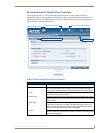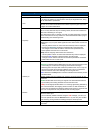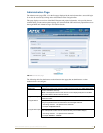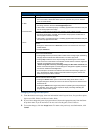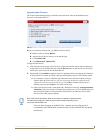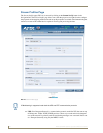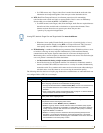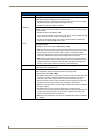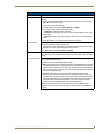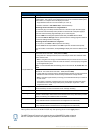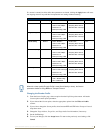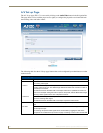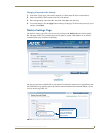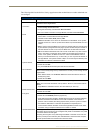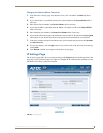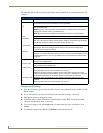
MAX-CSE Web Interface
29
MAX-CSE/MAX-CSD10 Operation/Reference Guide
Stream Profiles Page Features (Cont.)
Feature Description
• Sampling Rate A drop-down list from which the user can choose the sampling rate used on the audio
source.
• Sampling rate defines the number of samples per second taken from a continuous
signal to make it a discrete signal.
• Rate is measured in KHz (KiloHertz).
• Available audio sampling rates: 32KHz, 44.1KHz, and 48KHz.
• Some of the common uses for these rates include:
- 32,000 KHz - miniDV digital video camcorder
- 44,100 KHz - compact disc, also most commonly used with MPEG-1 audio (VCD,
SVCD, MP3)
- 48,000 KHz - digital sound used for digital TV, DVD, DAT, films and professional
audio
• At this time, 32KHz is not supported within the Modero firmware.
• Effective Rate A drop-down list from which the user can choose the amount of incoming audio data
throughput available for use by the MAX-CSE.
• The larger the amount of available audio data coming through the unit for encoding,
the better the outgoing audio quality to the target IP device.
• Available effective data rates: 96Kbps or 192Kbps
Stream: This section allows the user/administrator to define the transport protocols and destina-
tion parameters for the outgoing stream content (such as IP Address and Audio/Video
Ports).
• Transport Protocol A drop-down list from which the user can choose between the two types of available
data transfer/handling protocols.
Available transport protocols: UDP (default) or RTP
• UDP (User Datagram Protocol) allows the transport of both MPEG-2 video and audio
inside a single stream that is encapsulated as part of a standard MPEG-2 Transport
Stream. If UDP is selected as the protocol type, the Target Audio Port field becomes
greyed-out and unused. In this case, both the audio and video streams are combined
and sent to a single target port.
• RTP (Real-time Transport Protocol) defines a standardized packet format for
delivering audio and video over the Internet. By transferring video and audio over
separate streams, RTP allows audio only players to receive this separated content as
would their audio/video player counterparts. If RTP is selected as the protocol type,
the Target Audio Port field becomes enabled. In this case, the audio and video
streams are sent as separate entities to two separate target ports.
Note: The UDP Transport Protocol only supports the use of the MPEG-2 codec,
whereas the RTP Transport Protocol can support using both MPEG-2 and MPEG-4
codecs.



